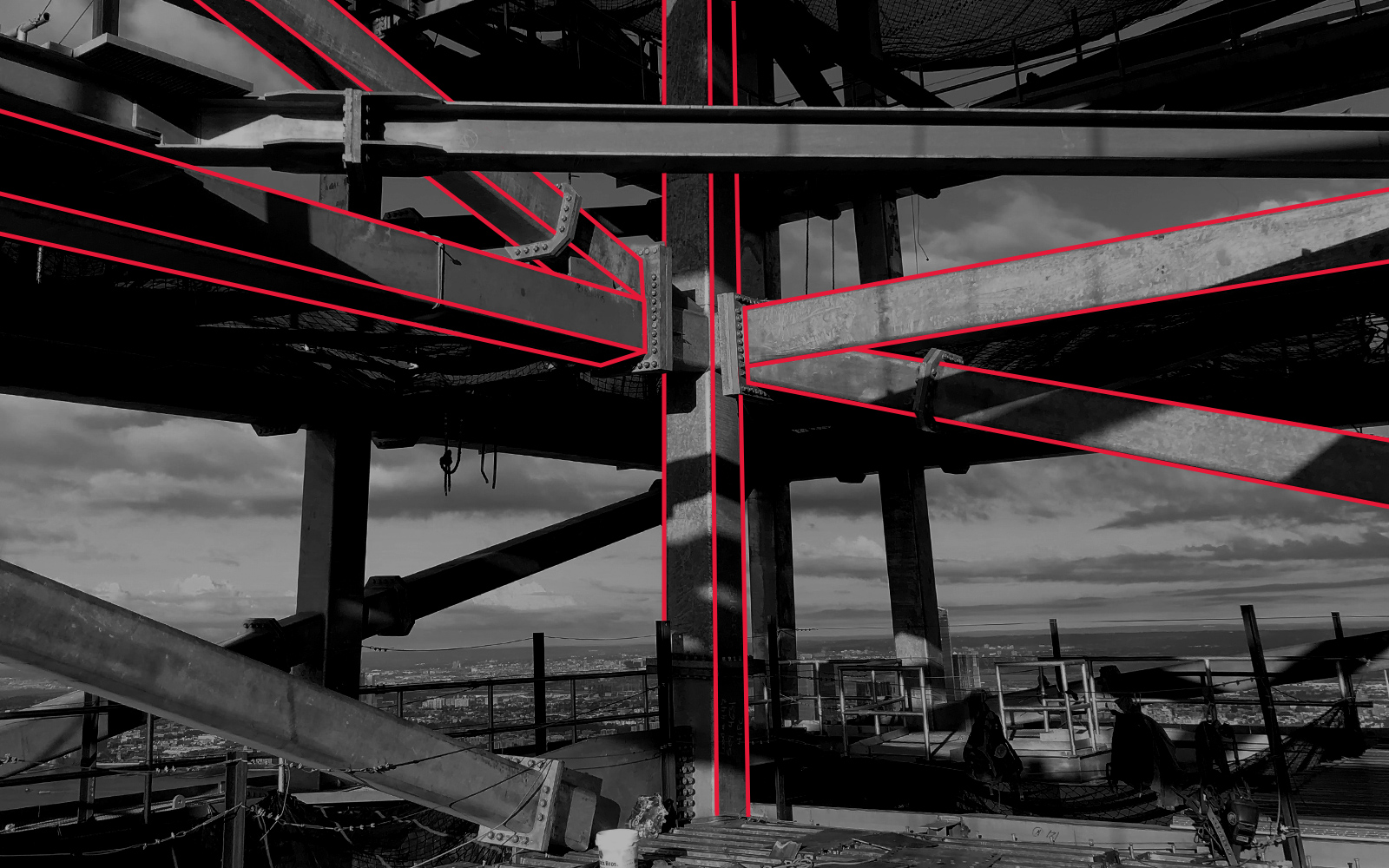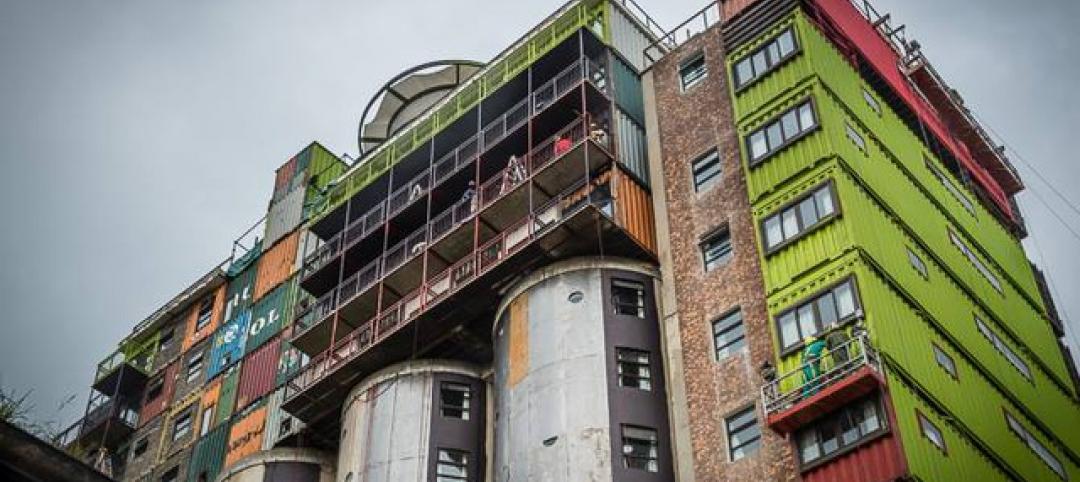One Vanderbilt, a recently completed, state-of-the-art office tower in New York City, is home to several leading finance, banking, law and real estate firms, including SL Green Realty Corp., which developed the building in partnership with Hines and the National Pension Service of Korea. Designed by architects at the acclaimed Kohn Pedersen Fox, the building’s elegant form is composed of four nested, prismatic volumes that taper as they rise and terminate at different heights. Capped by a 128-foot spire, the building reaches a height of 1,401 feet, making it the tallest office building in Midtown Manhattan and the fourth-tallest building anywhere in the city.
The Challenge
The simplicity of the external form belies the complexity of the structure behind it, especially on the upper floors, where the individual prismatic volumes diverge and their overlapping becomes more pronounced. Supporting the ins and outs of the curtain wall — a combination of vision glass and terra-cotta panels — would be enough of a challenge for structural engineering consultant Severud Associates. However, as with any tall building (especially supertalls), the top of the building also had to house the mechanical equipment designed by MEP consultant Jaros, Baum &Bolles, as well as elevator machine rooms, façade maintenance equipment and a tuned mass damper. After everything else was accounted for, there wasn’t much room left over for framing.
Lateral bracing, in particular, could not be accommodated. Nor could bracing be provided by floor diaphragms, which for the most part do not occur immediately behind the curtain wall. Instead, engineers needed to rely on structural members that would be unbraced for their entire length — up to 40 feet — while carrying a combination of axial loads, torsional loads and bi-axial bending loads. Further, the members would have to be interconnected to form an independently stable space frame cantilevering vertically from the main roof of the building.
Marrying Engineering and Aesthetics
 Photo credit: Severud Associates
Photo credit: Severud Associates
Working with the architects, engineers devised a system of concentrically braced frames immediately behind the curtain wall. The framing between the main roof on Level 60 and Intermediate Level 66.1 creates two C-shaped screens, one facing east and one facing west, that together came to be known as the Crown. Architecturally, this is the top of the middle two prismatic forms. At the center of the building, nested within the Crown and rising from Level 64 to Level 68, is a square macro-tube that designers called the Snorkel. Architecturally, this is the top of the highest prismatic form (the lowest prismatic form terminates just above the main roof).
The architects decided to embrace the diagonal members rather than conceal them, expressing their presence in the curtain wall design. Within the east half of the Crown, aluminum accent strips follow the diagonals while terra-cotta spandrel panels at the horizontals create a transition between the typical floors below and the formal top of the building. On the west side of the Crown, the terra-cotta spandrel panels are replaced by aluminum accent strips, and aluminum panels occur at the diagonals of the Snorkel to further distinguish the individual forms and direct the eye upward to the base of the spire. Despite the aluminum panels, most of the structural framing can be seen through the curtain wall. The engineers would have to select framing sections that would reinforce the architect’s desired aesthetic.
Atlas Tube Delivers
Hollow structural sections — HSS — were a clear choice. Based on the inherent stability of their closed cross sections, HSS are rarely governed by lateral-torsional buckling. This maximizes their potential capacity in bending, even for sections with large aspect ratios. And with a minimum yield strength of 50 ksi, that potential capacity can be usefully high. Even so, analysis determined that the vertical and horizontal elements would need to be 22" square (HSS 22" x 22"), while the diagonals would need to be 18" square (HSS 18" x 18"). In the steel industry, these are considered “Jumbo HSS.”
Supporting Possibilities With Domestic Manufacturing

During One Vanderbilt’s construction, the only way to get Jumbo HSS sizes was by sourcing from overseas manufacturers, leading to potential headaches from long lead times and schedule overruns. However, Atlas Tube’s relationship with Japanese steel producer NSMP provided a path to bring these large HSS to North America and make this project successful.
Fortunately for future projects, overseas shipping problems with Jumbo HSS are a thing of the past — with the opening of Atlas Tube’s new mill in Blytheville, Arkansas, the world’s largest HSS are rolled right here in North America. That means sizes up to 22" square and walls up to 1" thick, all available with the shortest lead times in the industry.
Planning for Connections
There were other considerations in the decision to use HSS at One Vanderbilt. Tubular sections lend themselves to shop-welded connections, which are relatively easy to fabricate and visually unobtrusive. The architects permitted field-bolted end-plate splice connections, and this greatly facilitated erection. The vertical members were detailed with stubs for the horizontal and diagonal members. These, in turn, were fabricated as straight pieces with square connections at each end. Tubes also work well in locations that are exposed to weather — except for their tops, there are no horizontal surfaces on which rain, snow or ice can accumulate. All of the HSS framing and connections were galvanized to prevent corrosion.
Using Jumbo HSS sections at the top of One Vanderbilt realized the architect’s vision for the building in an efficient, erectable and enduring manner; accommodated all the equipment that needed to occupy the upper spaces; and contributed to One Vanderbilt’s successful opening in September 2020.
About Atlas Tube
Atlas Tube, a division of Zekelman Industries, produces a wide range of steel tubular products and is the leading provider of hollow structural sections (HSS) in North America. Other offerings include HSS Design Tools and straight-seam electric resistance weld (ERW) pipe piling.
Get answers with Atlas.
For more information, call 800.733.5683 or visit atlastube.com
Project Team
Owner and Developer: SL Green Realty Corp.
Development Partners: Hines and the National Pension Service of Korea
Development Manager: Hines
Architect: Kohn Pedersen Fox
Interiors Architect: Gensler
Structural Engineering Consultant: Severud Associates
MEP Consultant: Jaros, Baum &Bolles
Geotechnical Consultant: Langan
Wind Tunnel / Microclimate Consultant: RWDI
Construction Manager: AECOM Tishman
Foundation Contractor: John Civetta& Sons
Structural Steel Contractor: Banker Steel
Concrete Contractor (Superstructure): Navillus
Curtain Wall Contractor: Permasteelisa
Related Stories
| Feb 20, 2014
5 myths about cross laminated timber
A CLT expert clears up several common misconceptions and myths surrounding the use of wood as a building material.
| Feb 14, 2014
Scrap tires used to boost masonry blocks at Missouri University of S&T
Research could lead to blocks that use waste material and have seismic and insulating benefits.
| Feb 14, 2014
Must see: Developer stacks shipping containers atop grain silos to create student housing tower
Mill Junction will house up to 370 students and is supported by 50-year-old grain silos.
| Feb 5, 2014
7 towers that define the 'skinny skyscraper' boom [slideshow]
Recent advancements in structural design, combined with the loosening of density and zoning requirements, has opened the door for the so-called "superslim skyscraper."
| Jan 28, 2014
2014 predictions for skyscraper construction: More twisting towers, mega-tall projects, and 'superslim' designs
Experts from the Council on Tall Buildings and Urban Habitat release their 2014 construction forecast for the worldwide high-rise industry.
| Jan 27, 2014
A climber's dream: Rock climbing hall planned near Iran's highest peak
Forget the rock climbing wall. A developer in Iran is building a rock climbing hall. That's right, an entire building dedicated to the sport, with more than 48,000 sf of program space.
| Jan 21, 2014
Comcast to build second Philadelphia skyscraper, with Norman Foster-designed tower [slideshow]
The British architect last week unveiled his scheme for the $1.2 billion, 59-story Comcast Innovation and Technology Center, planned adjacent to the Comcast Center.
| Jan 7, 2014
Concrete solutions: 9 innovations for a construction essential
BD+C editors offer a roundup of new products and case studies that represent the latest breakthroughs in concrete technology.
| Dec 31, 2013
BD+C's top 10 stories of 2013
The world's tallest twisting tower and the rise of augmented reality technology in construction were among the 10 most popular articles posted on Building Design+Construction's website, BDCnetwork.com.
| Dec 16, 2013
NASCC: The Steel Conference presents special seismic sessions
Twenty years ago the Northridge Earthquake shook California and the results surprised designers throughout the U.S. AISC and the steel industry is presenting a special series of sessions at the 2014 NASCC: The Steel Conference examining the lessons learned and the state-of-the-art in seismic design.















